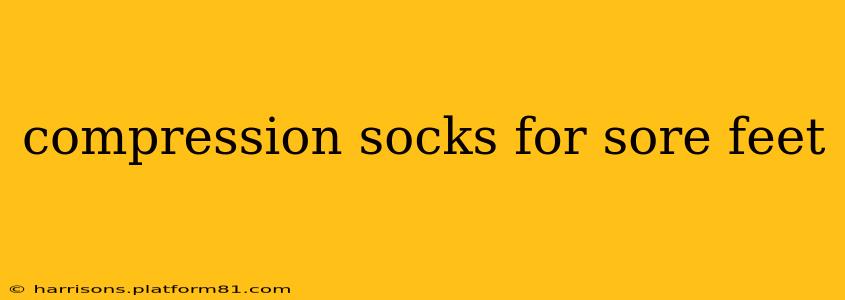Sore feet can significantly impact your daily life, causing discomfort, limiting activity, and affecting your overall well-being. While rest and elevation are often recommended, compression socks offer a proactive and supportive approach to alleviating foot pain and promoting healing. This comprehensive guide explores the benefits, usage, and considerations of compression socks for sore feet.
How Do Compression Socks Help Sore Feet?
Compression socks work by gently squeezing your legs and feet, improving circulation. This increased blood flow delivers more oxygen and nutrients to the tissues, speeding up the healing process and reducing inflammation. The compression also helps to support your arches and reduce swelling, which can be major contributors to foot pain. This targeted pressure helps to prevent pooling of blood in the lower extremities, a common cause of discomfort and fatigue in the feet.
What Types of Foot Pain Do Compression Socks Help With?
Compression socks can provide relief from a variety of foot pain conditions, including:
- Plantar fasciitis: The gentle compression helps to support the plantar fascia ligament, reducing strain and inflammation.
- Achilles tendinitis: Improved circulation can help to reduce pain and inflammation in the Achilles tendon.
- Foot swelling (edema): Compression socks effectively reduce swelling by promoting better blood flow and preventing fluid buildup.
- Metatarsalgia: Compression can provide support to the metatarsal bones, lessening pain and discomfort.
- Post-exercise soreness: They aid in muscle recovery and reduce inflammation after strenuous activity.
It's important to note that while compression socks can be beneficial, they are not a cure-all. Severe or persistent foot pain should always be evaluated by a medical professional.
What is the Best Compression Level for Sore Feet?
The level of compression is measured in mmHg (millimeters of mercury). For general foot pain and swelling, a compression level of 15-20 mmHg is usually sufficient. Higher levels (e.g., 20-30 mmHg or 30-40 mmHg) are generally recommended for specific medical conditions and should be prescribed by a doctor. Always follow the manufacturer's instructions and consult with your healthcare provider to determine the appropriate compression level for your needs.
How to Choose the Right Compression Socks for Sore Feet?
Choosing the right pair of compression socks involves considering several factors:
- Material: Look for breathable fabrics like cotton, nylon, or blends that wick away moisture to prevent sweat and discomfort.
- Size and Fit: Proper sizing is crucial for effective compression. Measure your calf circumference and follow the manufacturer's size chart carefully. Socks that are too tight can restrict blood flow, while socks that are too loose won't provide sufficient compression.
- Length: Consider ankle, calf, or knee-high options based on your needs and preferences. Knee-high socks offer broader compression support.
- Toe Style: Choose between closed-toe or open-toe styles depending on your comfort level and foot condition.
How Long Should I Wear Compression Socks for Sore Feet?
The recommended wearing time for compression socks varies depending on the individual and their specific condition. It's generally recommended to wear them throughout the day, especially during periods of prolonged standing or activity. However, you should remove them at night to allow your legs and feet to rest. Always listen to your body and remove the socks if you experience any discomfort or unusual sensations.
Can Compression Socks Help Prevent Sore Feet?
Yes, compression socks can be used proactively to prevent sore feet, particularly for individuals who spend long hours on their feet or engage in strenuous activities. The improved circulation and support can help to reduce fatigue and prevent swelling, minimizing the risk of developing foot pain.
Are There Any Side Effects of Wearing Compression Socks?
While generally safe, some individuals may experience mild side effects like tingling, itching, or discomfort. These side effects are usually temporary and resolve once you become accustomed to wearing the socks. If you experience persistent or severe side effects, discontinue use and consult with your healthcare provider. Individuals with certain medical conditions, such as peripheral artery disease (PAD), should consult their doctor before wearing compression socks.
This information is for general knowledge and does not constitute medical advice. Always consult with a healthcare professional for any concerns about your foot health.
